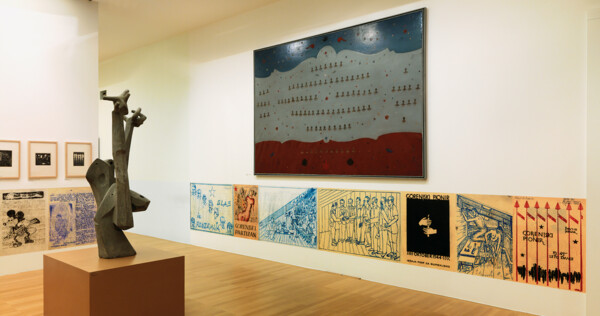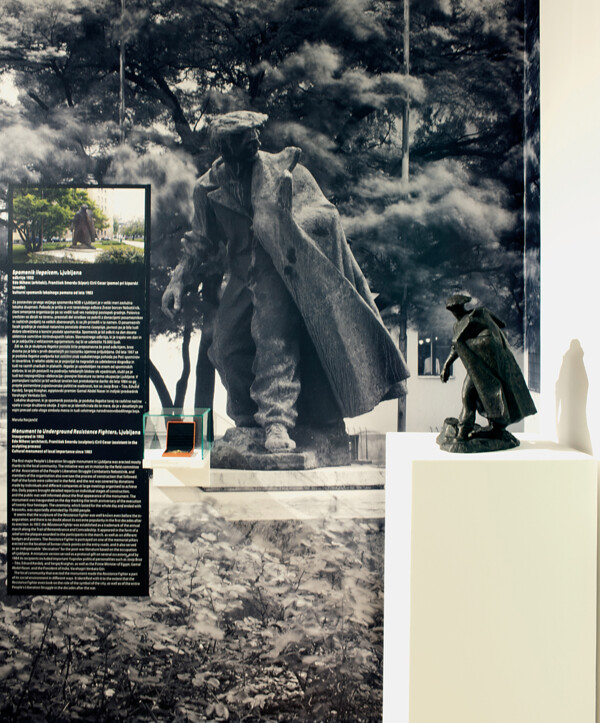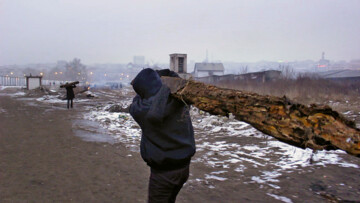Ten Years Later
Over ten years ago I curated an exhibition entitled Interrupted Histories. It stemmed from a then topical need to rethink the subject of historicising, which could also be called the narrator of historicising, since it is a particular voice – the teller of the story that remains present in it. Who is speaking and from where is crucial for our understanding of historicising.
I would like to explain at the outset what historicising means to me. It is no mere “making of history” with the idea of an end product in mind that is then upgraded as new discoveries are made. The emphasis is rather on discontinuities, on incessant interruptions, and on questioning the achieved results. Historicising is a history-in-becoming, something quite different from, and indeed, almost critical of, the process of merely including what is new into the existing system; it is based on a heterogeneity of approaches to and ways of dealing with history.

“Partisan Resistance Movement” in 20th Century. Continuities and Ruptures: A selection of works from the national collection of Moderna galerija, exhibition view, Moderna galerija, Ljubljana, 2011—. Photo courtesy of Moderna galerija, Ljubljana.
History has always been an instrument of the powers that be. After the fall of socialism, and with it the one-party systems in Eastern Europe, the groups trying to appropriate history grew in number. As alternative histories began to emerge, we witnessed almost equally intense attempts to erase the past, or rather, those parts of it that did not fit in with the dominant narratives of the various political groups. I would like to briefly describe how the Moderna galerija reacted to the danger of important → emancipatory traditions disappearing from our space. A few years after the Interrupted Histories exhibition, in 2011, we included a presentation of the art of the Partisan resistance in our permanent exhibition of the national collection of 20th century art, thus interrupting the national canon of modern art based on its linear development. Partisan art had nothing to do with the progression of modernist styles, evolving as it did within the frame of the Partisan resistance movement against the occupying forces in the Second World War, which encouraged the creativity of the masses. Our next presentation of emancipatory traditions, which are currently equated with totalitarianism by right-wing politics, and as such relegated to useless historical relics, came in 2017: a documentary show about the monuments to the National Liberation Struggle erected in the time of the Socialist Federative Republic of Yugoslavia. Entitled The Lives of Monuments, the exhibition was staged on the initiative of and in collaboration with the students of the Department of Art History of the University of Ljubljana. This → collaboration is an example of an alternative approach to historicising, since it arose out of an urgent need of the interested public – in our case, the need of the generation born at the time of the breakup of Yugoslavia – to understand the socio-political and cultural context of the monuments as well as the current antagonisms concerning their treatment and reception.

The Lives of Monuments, exhibition view, Museum of Contemporary Art Metelkova, Ljubljana, 2017. Photo courtesy of Moderna galerija, Ljubljana.
We can find a similar need expressed already in the Interrupted Histories exhibition, a need that essentially determines the subject of historicising: the need of the artists to better understand their work through their own local traditions.
Soon after the fall of socialism, the approaches to Eastern European post-war avant-gardes got caught between disparate interests: those related to the wish to create fairer, more just histories, and those dictated by the international art system and its market. In both cases the → construction of more complex local histories is a prerequisite for any further modernisation of the local art systems, which includes more sovereign exchange of ideas at the international level. This does not imply merely making previously lesser-known artistic traditions more visible, but a complex treatment of the heritage of the avant-gardes, also encompassing the other models of cultural production which emerged out of said artistic practices.
The artistic models of historicising presented in the Interrupted Histories exhibition served as an aid in establishing dialogue with non-institutional producers of knowledge from a variety of → interest groups in the years after the show. In the confederation L’Internationale, these interest groups could be called constituents, i.e. partners with whom the institution produces common knowledge.
Today we talk of the insufficiency or failings of expert knowledge and of the significance of bottom-up approaches and experiences. The global world seems too large to be encompassed with a single epistemological model. The increasingly intense migrations of knowledge and people are changing the Western epistemological models. The heterogeneous ways of historicising presented in the Interrupted Histories exhibition can be helpful today, in our time of increasingly extreme right-wing positions, xenophobia, and populism, all endorsing the → continuity of a history of a “pure” community, given once and for all. With the current arrivals of refugees from the Middle East and Africa, the structure of the population in Europe is rapidly changing. We are faced with the need for a different organisation of memory, one that would also allow a future for people who do not share our past. And once again, as often throughout history, it is artists who propose through their works ways to historicise an experience without its place in the existing histories and their methodologies. [1]
The Interrupted Histories exhibition called attention to the heritage of Eastern European avant-gardes that remains very much alive today. It is the legacy of the builders of alternative ways of cultural production, which also include various means of historicising.
Parallel histories
When we speak of the canonical history of the West, we are aware that in the Western world there has always existed, in parallel, much that has been marginalised or afterwards erased and forgotten. We are aware that today, even in the West, the number of subordinate histories is multiplying and that fewer and fewer people can identify with the unified collective narrative, which, as we increasingly discover, is linked to an imaginary community. As Homi Bhabha points out, in a period of time-space compression, hybridity replaces feelings of national and personal identity. In his view, today’s archetypal figure is the → migrant who lives between different cultural spaces. Despite the elusiveness of the identity of the migrant, this nevertheless appears as a universally recognisable category.
When discussing the expression “collective identity”, I said that its meaning essentially depends on the individual social and political context. I could say something similar about the term “parallel histories”: it is used differently in different contexts. It varies substantially depending on which official history the little histories are parallel to. There exists, indeed, enormous differences between the dominant systems and their relations with subordinate systems. In regard to the dominant Western system of art we can say with certainty that it has always been much more flexible toward its marginal histories, which it has even been able to graft fairly quickly into the big history. The unofficial art that existed under the more rigid forms of communism, however, represents a different story; it attained legitimacy, for the most part, only after the collapse of the regimes. One of the essential features of art in spaces dominated by ideological art was its inherent parallelism. If, then, we today wish to develop in these spaces an art history that would be at all relevant, we must take into consideration the fact that there were always two entirely separate parallel currents – official and unofficial. Unofficial art was the only truly parallel art, since it never overlapped with official art. If we consider the full meaning of the word “parallel” then we must distinguish between parallel histories and subordinate histories. Of the latter we can say that they are historical lines that synchronously form the → networks of a system in which they continuously appear and disappear, interrupting and transforming each other. Subordinate histories are characteristic of all spaces and – at least in the spaces presented at out our exhibition – also imply an art that is subordinate to the art of the dominant political, ethnic, or religious communities and, in some places, subordinate also to the art of a diaspora or the art of the West. In short, we can speak of a system of interrupted histories, which would seem to be, for now, something negative that should be brought to an end. But despite such desires, interruption is in fact the only constant we can find in various times and places.
It would be a mistake to think that, with the collapse of the political regimes and the rapid acceleration of the processes of global integration, things would somehow automatically normalise, that interrupted histories would be done away with and art would organise itself as part of a system of continuities. On the contrary, after the fall of the communist regimes, just when we expected a great wave of normalisation, new interruptions appeared. Today we are witnessing, for example, amnesia about the communist past – but this is not amnesia about the degeneration of communism, but rather about the progressive humanist idea, which suddenly found itself erased from the public space. This contemporary interruption was possible, among other reasons, because of the existing tradition of the truly radical interruptions that had resulted also in the creation of parallel systems.
Mapping interrupted histories
We have stated that art history, in the sense of a unified collective narrative, exists only in the West and that other spaces are, by and large, spaces of interrupted histories. In this regard, interrupted histories are in fact individual stories that live separate lives from one another and that cannot be joined together, on the basis of unified standards, into a larger meaningful whole. These are smaller, fragmented systems that map the national histories outside of any broader international connections – or they map the little histories of individuals and groups that shape the unofficial mythologies of the given spaces.
One such system is the → self-historicising of artists who, lacking a suitable collective history, were themselves forced to search for their own historical and interpretive contexts. Because the local institutions that should have been systematising neo-avant-garde art and its tradition either did not exist or were disdainful of such art, the artists themselves were forced to be their own art historians and archivists, a situation that still exists in some places today. Such self-historicisation includes the collecting and archiving of documents, whether of one’s own art actions or, in certain spaces, of broader movements, ones that were usually marginalised by local politics and invisible in the international art context.
Self-historicisation was only one of the systems that existed alongside the activities of institutions, which themselves have always been extremely diverse in the spaces of Eastern Europe and the Middle East. They range from thoroughly provincial museums to museums with enviable collections in Russia, the former Yugoslavia, Israel, and Iran. In some places – Palestine and Lebanon, for instance – they did not exist at all; only recently have smaller non-profit art organisations begun to compensate for this absence. Nevertheless, despite all these differences in institutions, we can say that they were what, for the most part, provided local artists with a national or ideological frame, even if had no informed relationship with either the narrower local art scene or the broader international context.
Artists today find themselves in a situation where, on the one hand, they are still to a large degree left to do their own historicising while, on the other, the newly interested West has already started to include them in its museum collections – where they find themselves → estranged from their own original context. Thus begins the musealisation of the East, a process that Boris Groys, when speaking of the art of communism, describes as “a consequence of the West’s victory in the Cold War: we know from history that the victors always, in one way or another, appropriate the art of the vanquished”. We have already stated that the musealisation of the non-Western world essentially means classifying it and making it more manageable. The greater visibility of the Other, then, does not automatically imply greater power. Why, therefore, should we be at all interested in modernising our art and its system of operations if it is clear that this does not enhance our sovereignty but instead takes it away?
In modernisation we see a double process. It is, simultaneously, both a possible means of achieving independence and a key method for new forms of colonialism. It is, indeed, a stimulant that, on the one hand, strengthens and, on the other, destroys. And as with any medicine, in these processes, too, dosage and combination with anything of a different “chemical makeup” are essential issues.
Today’s split between tradition and modernity, which, especially in the non-Western world, is becoming ever more acute, is based precisely on the understanding that these two entities are fundamentally incompatible. We have already found that today traditional identity essentially implies a reiteration of something that supposedly cannot change over time. If we want today to historicise a certain artistic space – without abandoning it to the jaws of such dichotomies – our only recourse is to recognise both → the contemporary plurality of identities and the social, political, and historical specificities of individual localities. Only by taking account of both these things can we avoid both the traditional and modern reproductions of identity that are stimulated by the contemporary world of the media. We are speaking, then, of new possibilities that reside in a historicising that no longer views identities as finalised facts, but instead always allows for the discovery of yet-unlabelled subjectivities. If we want to talk about any sort of power that peripheral spaces might have for transforming the existing state of affairs, then we must look for it in this quality of being actively unlabelled.
We spoke earlier of parallel and subordinate histories – in other words, the informal histories that continue to be an especially characteristic feature of the non-Western world. In these environments, we could, indeed, speak of a whole range of informal systems, which people were compelled to develop alongside official political and military dictatorships so as to survive more easily. From the perspective of the modern world, these informal systems look like huge obstacles on the road to economic progress and the development of a mature political democracy. For this reason they are usually presented as features of the Other that need to be dispensed with as soon as possible for the good of modernisation. In its critical stance toward the world of modernity, art today often turns to what are essentially premodern systems in which it sees a certain subjective creativity that has almost disappeared from the standardised capitalist world. In this way it views informal systems as a positive; the Other is no longer merely the object of modernisation but has become an active Other. Here we are dealing not with any romantic nostalgia, but rather with a recognition of the modes of operation that, together with artefacts, compose the history of the Other.

Nika Autor, Newsreel 63 – The Train of Shadows, 57th International Art Exhibition – La Biennale di Venezia, Slovenian Pavilion, 2017. Courtesy of the artist.




